To Detect and Protect
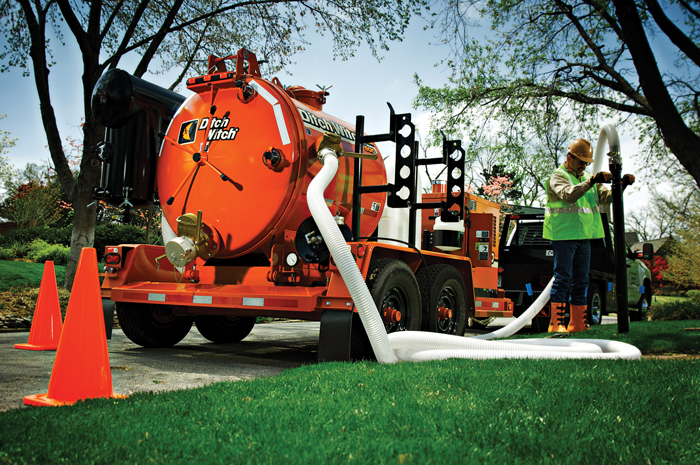 The importance of damage prevention when digging around underground utilities cannot be understated. By avoiding a utility strike, contractors not only protect their company, but the public from potential danger or lost services. Before excavation, One-Call provides a great starting point at identifying a utility’s location. To further minimize risk, vacuum excavators can be called in to expose a utility and prevent crews from accidentally striking it — saving them from causing dangerous and costly damage.
The importance of damage prevention when digging around underground utilities cannot be understated. By avoiding a utility strike, contractors not only protect their company, but the public from potential danger or lost services. Before excavation, One-Call provides a great starting point at identifying a utility’s location. To further minimize risk, vacuum excavators can be called in to expose a utility and prevent crews from accidentally striking it — saving them from causing dangerous and costly damage.
“With more than 19 million miles of buried utilities in the United States, vacuum excavation helps contractors to quickly and efficiently locate underground utilities while protecting the vulnerable and expensive infrastructure,” says Ben Schmitt, Product Manager for Vactor Mfg. “The risk of striking a fiber-optic, electrical or gas line is too great not to visually locate the utilities in the area before excavating mechanically. The result can be thousands, and sometimes millions, in fines, lawsuits and even death.”
Vacuum excavation technology has been around in some shape or form since the 1950s. And as the demand for their services increased, so did the innovations in the machines — leading to both growth in sales and labor force.
“There has been tremendous growth in the industry, resulting in an increased number of new vacuum excavator operators to meet the demand,” says Schmitt. “Vacuum excavators must be easy to operate and safe for both new equipment operators and experienced operators. A struggle for many contractors is finding skilled workers to operate the vacuum excavation equipment.”
With vacuum excavation becoming more and more popular, the units have evolved to better accommodate their users. Manufacturers are steadfast in finding ways to ease the labor and maintenance requirements of these machines, while maintaining productivity.
“As great as these units are to promote safety and prevent strikes, there’s still manual labor that’s required to operate these units,” says Jason Proctor, Product Manager for Ditch Witch. “I think we [manufacturers] continuously look for opportunities to make it easier on the operator.”
With contractors in mind, manufacturers have been perfecting their models with quite a few operator-friendly features in mind. Jeff Wage, Vice President of McLaughlin, points out that the rear door on a vacuum excavator has evolved from something fairly basic into a more advanced design — all in the name of easier use, reliability and improved locking mechanisms.
“Most of the early rear door designs were rather rudimentary,” he says. “The door would have some sort of manual latch or mechanical nut/bolt securing method and require the contractor to back the unit into the area where he was going to dump the spoils and stand in them as he opened the rear door to empty the tank. Over the past three years, the trend has moved from these manual doors into having a hydraulic rear door to operate via a remote control or toggle switch. This allows contractors to open the door hydraulically and not stand behind the machine.”
Another trend has been the use of a hydraulic boom. This feature has significantly reduced the stress on contractors by taking the load off of them.
“Based on customer feedback, it’s all about safe, ergonomic operation,” says Proctor. “Hydraulic booms ensure that the operator doesn’t have to hold or support the hose throughout a long workday. We even look at operator-friendly features such as controls on the curb side to keep operators out of traffic and putting everything within good reach of the operator for easy access and easy service.”
The Great Debate
When exploring vacuum excavation systems, the decision between an air or hydro unit is an important one. While both have their own advantages and disadvantages, hydro continues to be the most popular among contractors, thanks to its speed and productivity.
“Water is much more productive in the majority of soils, particularly tight clays and heavier, denser materials,” explains Proctor. “Overall, from what we see, it’s what’s preferred in the industry. The real downside is that your spoils are wet and may not be reusable.”
Hydro-excavation units work well in frozen ground or when working with harder materials. On-board water heaters may be used to warm the water and aid it in cutting through the soil. According to Schmitt, water also works as a lubricant. “The water helps to prolong the life of the excavation equipment by reducing wear on the vacuum hose and other components in the air stream,” he says.
Although it seems hydro may rule supreme, air is definitely on the industry’s radar. Wage points out that McLaughlin has seen some interest from contractors in air-excavation machines.
“There has been a push toward air excavation recently,” he says. “Depending on the market, contract and soil type of your project, it can be a real benefit to keep the soil dry and reuse those spoils if possible. Air can eliminate the need to haul off spoils and bring in new material. We see air excavation working very well in sandy or fractural soils. When you look at units sold or market percentages, air is still such a small percentage of the units supplied.”
On top of reusing spoils, air also offers contractors a limitless resource since on-board compressors generate the required pressure on demand, Schmitt points out. With an air-excavation machine, there’s no need to refill water. However, air does cause a fair share of sandblasting when in use, so the potential for flying debris is greater than with water.
If a contractor is on the fence on which medium to use, air and hydro combination units are an option and becoming a popular choice for anyone who wants the best of both worlds.
“There are some market segments that would prefer combination machines, such as the oil and gas industry when dealing with cathodic protection,” says Proctor. “However, if you have an air unit, there are going to be certain soils where air is just not productive and switching over to water is an absolute necessity. I don’t see too many units out there that are strictly air and have no hydro capabilities at all.”
To answer the call for combination units, both Vactor and McLaughlin have stepped up to the drawing board to address the demand for these unique machines.
“The speed of hydro excavation is too significant to overlook for general potholing, which is why utilities are looking for a machine with both capabilities,” says Schmitt. “Vactor Mfg. currently supplies the utility market with the HXX Prodigy, which has hydro excavation as its primary medium and air excavation as an optional medium for excavation.”
“At McLaughlin, we always pair our air units with water,” adds Wage. “We have built some air-only machines, but generally if someone’s asking for an air unit, it’s outfitted with water tanks and a pump. This protects them if they get into a scenario where air is not working or air is not allowed, they don’t have an asset that’s not usable or productive. About 99 percent of our air units are combo units.”
Properly identifying underground utilities prior to excavation is of utmost importance to avoid costly damage and unsafe working conditions. Vacuum excavation assists in locating and exposing utilities to minimize risk when digging and the use of these machines is expected to grow.
“Damage prevention is such a great driver for these products and it’s just going to continue,” says Proctor. “Vacuum excavation is a great answer to minimizing the liability to a contractor or anyone that’s working with ground-engaging equipment. It can really mean the difference for their business surviving and avoiding a strike of an underground utility.”
Pam Kleineke is Associate Editor of Utility Contractor.
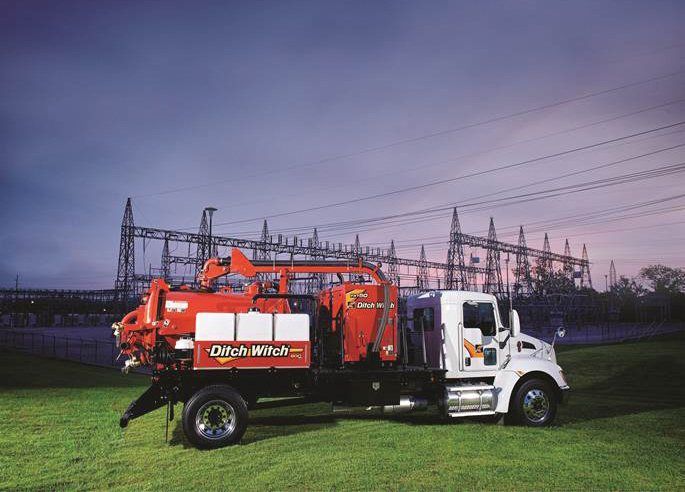 Ditch Witch
Ditch Witch
The Ditch Witch FXT50 Truck Vac mounts directly to your truck’s frame rails, maximizing structural integrity by allowing system components to flex independently of the truck. Skid-mounted vacs aren’t able to offer this level of stability. The FXT50 also promises an unprecedented level of flexibility to consumers. Ditch Witch dealers will mount the FXT50 to the single-axle truck of your choice. This allows buyers to not only choose the brand of truck they prefer, but also better control their initial investment by choosing either a new or used truck. Ditch Witch dealers are also able to customize the truck with toolboxes and other support equipment. The FXT50 features a 49-hp, Deutz diesel engine, an efficient 1,020-cfm blower and a powerful 3,000-psi water system with a flow of 5 gpm. The FXT50 offers both quiet operation and excellent filtration. For more information, visit www.ditchwitch.com.
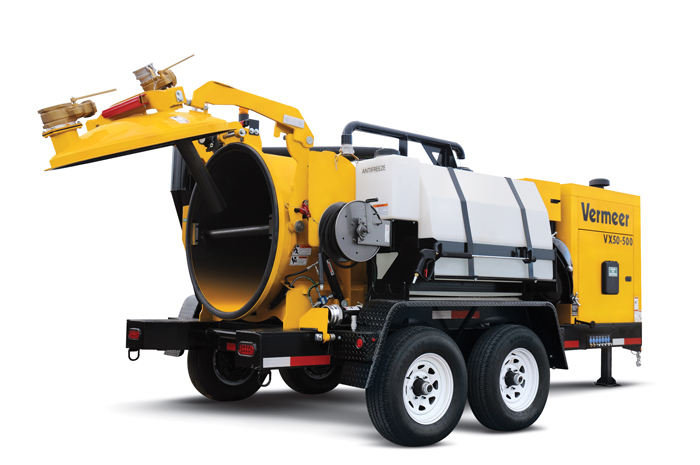 McLaughlin
McLaughlin
McLaughlin’s second generation vacuum excavator series feature Tier 4 Final engine technology that provides enhanced fuel consumption and a new engine enclosure to help reduce engine noise levels. A large access door to the engine enclosure provides improved accessibility to conduct service and maintenance. An improved external hydraulic door opens at an 85-degree angle, allowing for easier and more rapid dumping and cleaning of the spoils tank. A patented mechanical cam-over locking system provides a 360-degree positive door seal, even under reverse pressure, without additional clamping requirements. The units feature the McLaughlin industry-exclusive, three-stage filtration system that allows for both wet and dry vacuum excavation. First, material enters the tank at 130 mph where large soil particles lose velocity and fall out of the filtration system. Next, the air moves to a pre-filter cyclone where the remaining small particles drop into a collection tank. Finally, the pre-filtered air enters a washable micron-poly filter that traps the remaining fine particles. For more information, visit www.mclaughlinunderground.com.
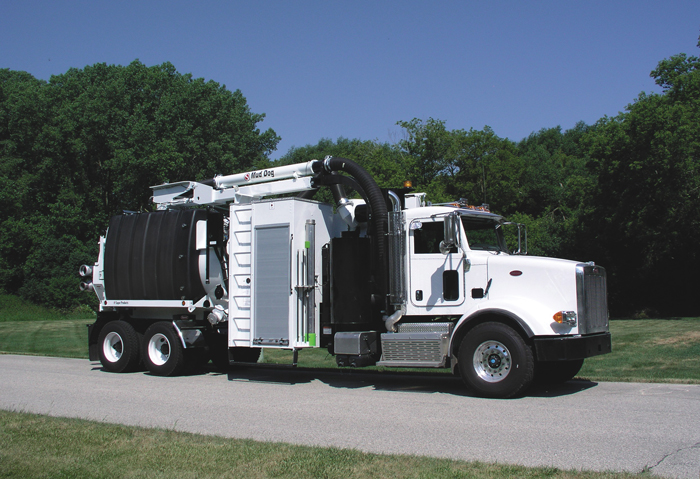 Super Products
Super Products
The Mud Dog 1200 and 1600 from Super Products each feature a rear-mounted boom capable of 335-degree rotation, 27-ft reach and 45-degree upward and 25-degree downward pivot. Super Products’ patent-pending Acculevel Load Sensor System precisely measures debris levels in the collector body. With the ability to operate in an extremely broad temperature range and immune to air flow, noise, vibration, dust and humidity, the Acculevel sensor continuously monitors the volume of collected material — whether liquid, solid or slurry. When the debris level reaches full capacity, the system automatically relieves the vacuum to prevent over-filling, which can result in lost productivity and wasted hours of cleanup. For fast, thorough and easy debris removal, Mud Dogs utilize Super Products’ exclusive ejector plate unloading system. And their “tilt-unloading” feature ensures liquids in the collector body are cleared quickly and efficiently even when unloading in an up-slope/nose down position. For more information, visit www.superproductsllc.com.
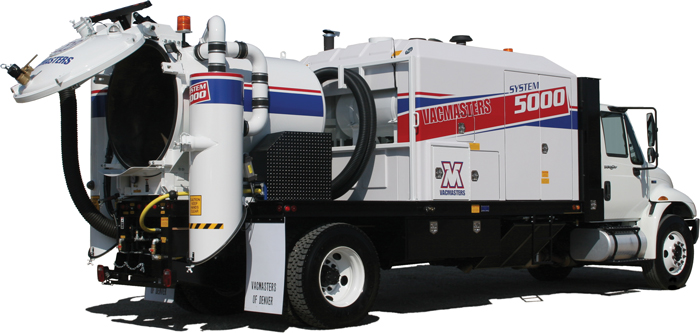 Vacmasters
Vacmasters
The SYSTEM 5000 is the newest addition to the Vacmasters air-vacuum excavation family. With 50 percent more vacuum power than the SYSTEM 4000, while offering the conveniences of a hydraulically powered, full-opening rear door, the SYSTEM 5000 makes utility jobs extremely fast while offering the same safety benefits of Vacmasters’ entire line of products. While maintaining a smaller footprint than larger vacuum excavation equipment, the SYSTEM 5000’s added vacuum speed will allow you to complete more billable work in a day’s time. For more information, visit www.vacmasters.com.
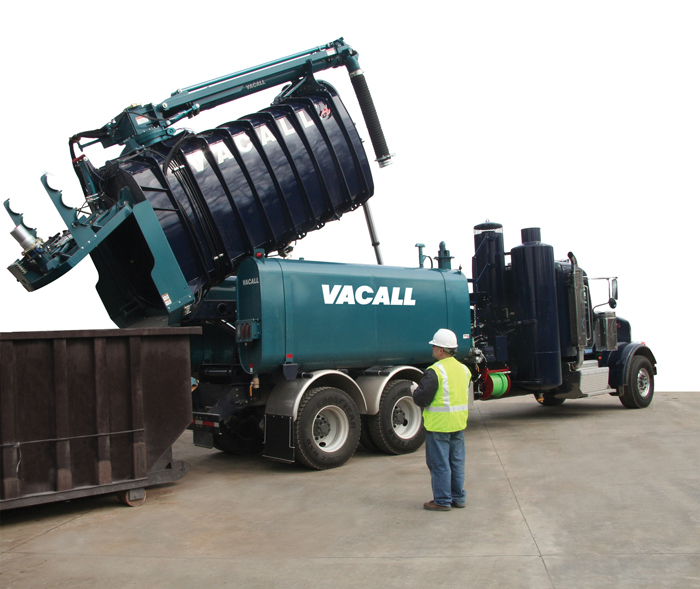 Vacall
Vacall
Vacall’s AllExcavate hydro excavation models are available with a popular cold weather package, assuring smooth, reliable performance during frigid winter weather. The package includes heated cabinetry that encloses the boiler, warming the water for hydro excavation when temperatures drop below freezing. Another popular option — high-dump capability — allows the operator to use a wireless remote control to raise the debris tank as much as 76 in. above ground level and then shift the tank horizontally 21 in. beyond the rear bumper. Unique to the industry, this option makes it possible to dump debris into roll-off containers, avoiding the need to travel off-site for dumping. Vacall AllExcavate hydro excavators use just one engine for mobility, as well as to generate water flow at 10 to 25 gpm and pressures up to 3,000 psi. Used in combination with strong vacuum forces, the AllExcavate can loosen and then remove dirt, rocks and other material from around utility lines and foundations. For more information, visit www.vacallindustries.com.
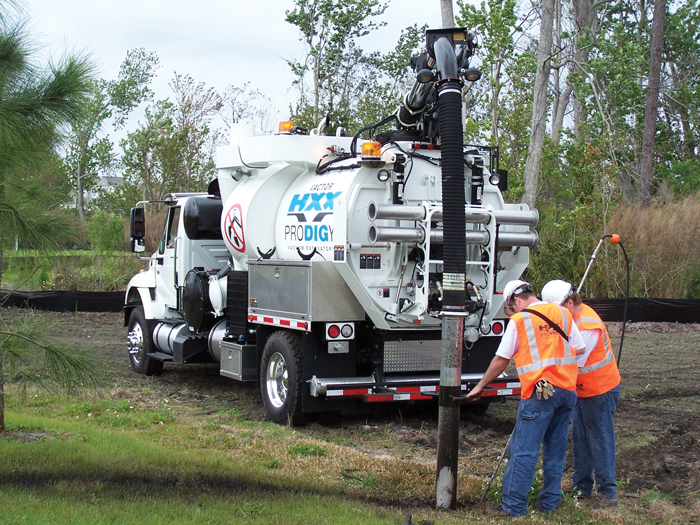 Vactor
Vactor
Vactor Mfg. has introduced new features on its HXX Prodigy vacuum excavator. Mounted on a 33,000-lb gross vehicle weight Class 7 truck chassis, the 2014 HXX Prodigy features a user-friendly control system identical to the controls used on the popular full-size HXX HydroExcavator and the addition of a standard extendable boom with 320-degree rotation that provides full coverage of the working area. The mid-size Prodigy uses hydro excavation, blasting away soil with jets of up to 10 gal of water per minute, at rates from 1,500 to 2,500 psi. The machine features a powerful 16-in. Hg, 3,200 cfm positive displacement (PD) blower with a custom-designed and optimized filtration system that can handle both digging mediums — air (185 cfm/150 psi) and water (10 gpm/2,500 psi) — without a bag house. The variable-pressure triplex pump allows the operator to adjust water pressure with the push of a button. For applications where dry digging is preferred, the Prodigy also comes with an optional air excavation system. For more information, visit www.vactor.com.




